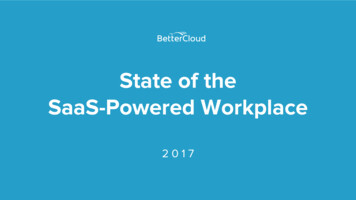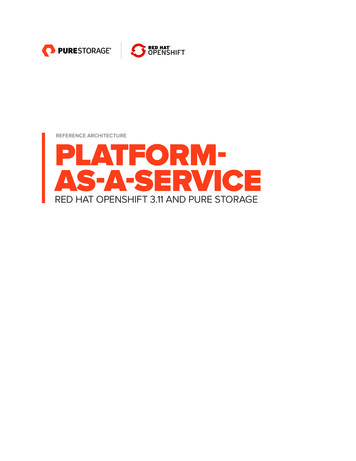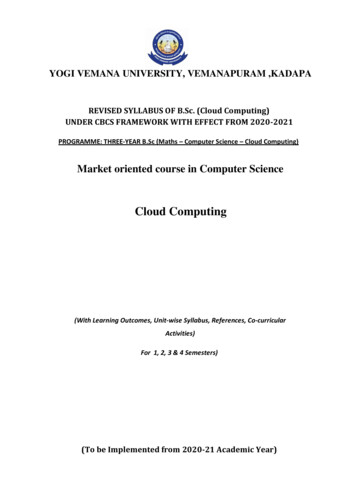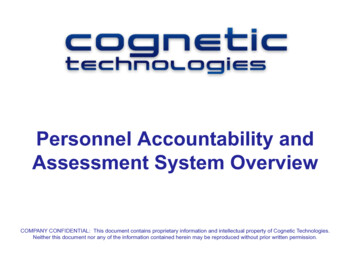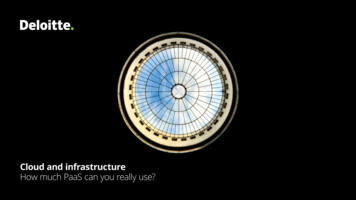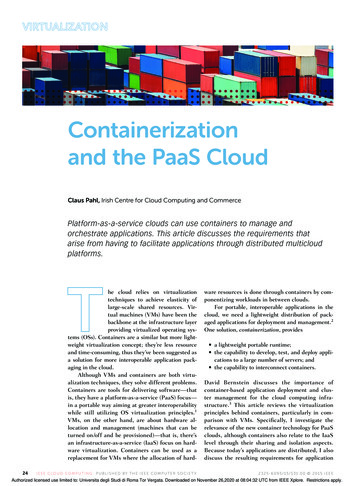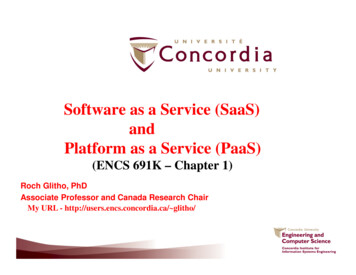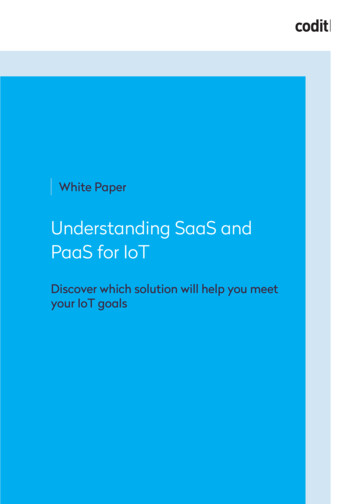
Transcription
White PaperUnderstanding SaaS andPaaS for IoTDiscover which solution will help you meetyour IoT goals
Table Of Contents1. Potato Chips and IoT.32. SaaS vs PaaS.42.1 IoT to optimize business process vs IoT for market differentiation. 42.2 Software as a Service (SaaS). 52.3 Platform as a Service (PaaS). 73. Azure IoT services.93.1 Devices. 93.2 Edge.103.3 Connectivity.103.4 Ingestion.103.5 Automation. 113.6 Data Analytics. 123.7 Report and Action. 134. Conclusion. 14Author: Sam Vanhoutte CTOE-mail: sam.vanhoutte@codit.eu 2019, Codit. All rights reserved.2
1. Potato Chips and IoTOnce upon a time, a potato chip making company organized a meeting with several engineers and external consultants, to help them solve an annoying problem. Customers had been complaining that whenthey purchased a bag of chips and opened them, the bag was empty and only filled with air. It started toreflect badly on their company, so they had to take action.They set up a special forces project team to solve the problem. Several months, and many euros later, theycame up with a solution – to weigh the chip bags. They poured a lot of money into designing a customizedweighing system perfect for their very specific needs. Finally, they had the perfect system and installedit in the factory. If the chip bag weighed too little, an alert was sent to an operator, who then logged theinstance in a system and removed the bag from the production line.At the end of the first week they held an evaluation meeting and they noticed that 10 empty bags weresuccessfully detected and never made it to the customers. Everybody was happy that they could nowstop these bags. A few weeks later, they were checking the reports again and to their great surprise, therewere no longer empty bags detected by the weighing scale.Thinking something must have gone wrong, they went to the line operator to verify the data. The operator, a very pragmatic person, said he didn’t like the alert system because it meant he had to log thingsand remove the empty bag manually. He therefore used a simple fan he bought off-the-shelf at thehardware store, which blew on the bags before they reached the weighing scale. The breeze was strongenough to blow away empty bags, but not so strong it would blow away full bags. The success didn’t liewith the new weighing system, but with the fan that just blew away every empty bag, so it never madeit further down the line.The above (probably fictitious) story shows that it’s important for companies, and their consultancy providers, to understand the problem that needs to be solved. When an Internet of Things architecture is thesolution to the problem, the first decision should be whether to take the approach of the operator (SaaS)or the approach of the special forces project team (PaaS). In the above example, the off-the-shelf SaaSsolution was clearly the right choice. But it won’t always be so simple.This white paper will walk you through the differences ofSaaS and PaaS IoT solutions, so that you can make thecorrect decision for your business needs.3
2. SaaS vs PaaS2.1 IoT to optimize business process vs IoT for market differentiationWhen organizations want to optimize their internal operations, increase efficiency or increase visibility, anIoT solution can be described as IoT to optimize business processes. The IoT solution is there to supportthe optimization of the running of the business.Some examples:Banks that want to save energy bymonitoring their bank affiliate buildings.Cities that want to provide real timeparking information to their citizens.IT companies that want to increasecomfort and productivity in their officesthrough a smart-office solution.A construction company wants to track andtrace their high-value assets.Other companies are applying IoT solutions to change the way their products are being placed in the market. They are adding connectivity to their devices and are trying to find new business models or enrichcustomer experience by delivering new features on their products. These solutions can be described asIoT for market differentiation.Some examples:A vendor of ventilation and heating machines adds connectivity to its devices to prove energyefficiency and allow efficiency improvements through AI.A startup that delivers smart parking solutions to cities connects parking sensors and provides thedata to its customers.A car manufacturer connects the cars in order to provide better user experience and predictivemaintenance capabilities to its customers.The decision for PaaS vs SaaS will quite often be different for organizations that are going for IoT tooptimize business processes vs organizations that need IoT for market differentiation. The first will mostbenefit from taking an off-the-shelf SaaS solution, while companies that are trying to differentiate theirproducts on the market will often find PaaS to be the right approach.4
Platform as a ServiceSoftware as a ServiceSaaSVSPaaSPaaS is best for companieslooking to custom build a solution.SaaS is best for companieslooking for an out-of-the-box ease of use.2.2 Software as a Service (SaaS)Software as a Service (SaaS) solutions are standard, production-ready solutions that are built to be usedby different customers. Quite often these solutions focus on delivering value in a specific vertical.Using IoT solutions that come as a SaaS offering has a lot of advantages. The time to get started andhave something running will be drastically lower compared with PaaS solutions. Quite often this results ina buy instead of build decision. While the speed of implementation and the time to value is much faster,there are definitely some things to watch out for.Four Things to Keep in Mind When Implementing SaaSOpennessFutureproof androadmapSaaSManagedofferingReliability5
2.2.1 OpennessNext to cost considerations, the openness of the solution you select is one of the most important thingsto consider in your selection process. Since you don’t own the code base of the SaaS solution you use, itis important that you are still able to integrate this solution with the specific systems or scenarios thatmight not be implemented by the solution. The out-of-the-box functionality might cover 80% of yourneeds, but it is still very important to have capabilities available that allow you to bridge the gap of theremaining 20% of the needs.It is important that you can get access to the actual data inside your tenant on the SaaS platform andit’s also crucial that you can subscribe or register to relevant events, detected or raised by the IoT solution.To ensure this can happen look for things like API’s, webhooks or streaming routes on the SaaS platform.Make sure you can access or extract your data, so that you can apply the analytics for your specific caseor make the integration to your specific business process.An IoT solution should never stand alone and should always be integrated with the rest of your company.2.2.2 Managed offeringIt is important to understand how the service you are using is supported and managed by the applicationprovider. If you are making your business (partially) dependent on the platform, it is important you canrely on a support team to be available in case incidents happen or software bugs should be solved.2.2.3 ReliabilityThere are a lot of commercially available SaaS offerings and one of the important things to keep in mindis the reliability of the solution, but also of the company that provides the solution. A lot of these companies are in a startup phase and this makes it important to understand their roadmap, their financialsituation and their customer installed base.2.2.4 Future proof and roadmapNext to that, it is also extremely important to understand the feature set and the roadmap of the solutionyou are buying. One of the main advantages of good SaaS platforms is that they constantly pushing newfeatures and further enhancing the platform with new capabilities or scenarios.With the typically monthly pay-per-use fee you pay, you should expect this from a standard solution.6
2.3 Platform as a Service (PaaS)The biggest advantage of PaaS also comes with the biggest challenge of PaaS. The fact that you are in fullcontrol of the feature set and the scalability of your application also demands that you build and fund it.Five Things to Keep in Mind When Implementing 2.3.1 Build what sets you apart, re-use what should be commodityOne of the biggest challenges in building a custom solution on PaaS technology, is the time to market foryour product.An IoT architecture consists of a lot of different components that are chained together, as depicted inthe schema. We believe you should focus on the logic and components that create the value and set youapart as an organization. And this can be done by building on available runtime components from the IoTplatform of your choice.This means it is not required to build everything from the ground up. Selecting the right technology platform will allow you to reduce the investment and to only custom build what is specific to your businessand what makes your product unique.7
2.3.2 Connectivity and device managementThe most important aspect in building your solution is the connectivity part. That is the part you must getright from the beginning. As soon as your products (the devices or machines) leave the factory, they are out ofyour physical reach. The only possibility to change or fix things is through software and internet connectivity.If your security breaks over time, you’ll want to have the option to push and fix this yourself in the shortesttimeframe, without depending on users to download and install a firmware upgrade.It can also be interesting to change configuration of push new features to a device.2.3.3 Product development, not a scoped projectWhen adding a software-based IoT solution to your existing (or new) devices, it is important to realize thatyou are in fact building a software product. This means it should typically be approached in a different waythan a traditional IT project, such as ERP migrations or the implementation of a new (e-commerce) website.It is important a clear roadmap (and roadmap owner) is defined. Maintaining and prioritizing the backlogfor your solution is important and the trade off triangle on budget, time and quality is constantly present.Release management, automated devops and product testing becomes extremely important and mightrequire new skills in the existing organization.8
3. Azure IoT ServicesThis section has no intention to give a detailed overview of all the services but wants to position the different available options and a short reasoning on when and where the service using a typical IoT solutionchain which is comprised of the following TAANALYTICSREPORT &ACTIONintelligentcloudeventThe IoT Value Chain explains the building blocks of an IoT solution and how they interact with each other3.1 DevicesMicrosoft has a rich and long history with embedded systems (Windows Embedded,Windows CE ). And more recently, Microsoft also offered Windows IoT. These servicesare all full Windows operating systems that get installed on compute devices.Cloud SecurityAnother very interesting service is Azure Sphere. This is a secure-first solution targeting MCU (microcontroller-unit) based devices. It comes with a Secured OS (Linuxbased!), Secured MCU and Cloud management. This is the perfect solution to build inembedded connectivity for connected products at large scale.AzureSphereSecured MCUSecured OS9
3.2 EdgeAzure IoT Edge comes as a free, open-source, container-based system that can be installed on edgedevices (such as industrial PC’s, raspberry PI or smart camera’s). This service allows customers to retrofitexisting devices or push AI closer to the actual devices – on the edge.Through custom modules, Azure IoT Edge enables customers to only focus on building the business specific logic, but gives the entire infrastructure for patching, updates and remotely configure IoT deployments in the field.How Azure IoT Edge WorksAzure IoT Edge DeviceModuleModuleModuleTelemetryInsightActionIoT HubAzure IoT Edge RuntimeInsights and module health3.3 ConnectivityThe actual connectivity from field to cloud is something that really depends on the actual deploymentand installation requirements for the field devices. Regardless if the devices (or the edge) connects throughWIFI, Sim card or fixed cable, the Azure IoT Hub allows to leverage the firewall friendly protocols (AMQP,MQTT or even HTTPs) to have bi-directional communication between device and cloud. Important concepts such as buffering, retries and batch processing are built-in.10
3.4 IngestionThe de-facto service on Azure for telemetry ingestion and device commands is Azure IoTHub. This service is the link between the field deployments and the cloud solution. AzureIoT Hub offers geo-scale connectivity and telemetry ingestion.But Azure IoT Hub has a lot of extra services that are important to build real IoT solutions: ConfigurationManagement, Telemetry Routing, Device Provisioning Service and Edge capabilities.3.5 AutomationThe automation layer in the value chain is responsible for executing business logic on the incoming telemetry data or handling and delivering device commands that come from the integration layer.There are a lot of compute options on the Azure platform and almost all of them have out-of-the-boxintegration or connectivity with Azure IoT Hub.The following list shows most of these services:Azure Functions: this is the Microsoft implement for serverless lambda and allows usersto have a configuration-based binding to Azure IoT Hub and execute code (that autoscales) in the language of their choice.Azure Kubernetes Services (AKS): this is a fully managed Kubernetes container orchestration service that allows organizations to build container-based micro-services architectures that process telemetry data.Other options:Azure Service FabricAzure Logic AppsAzure Data Factory11
3.6 Data AnalyticsThis is where the highest value is mostly achieved in the project lifecycle. The options for Data Analyticsare numerous:Azure Databricks: this is the first-class citizen implementation of Apache Spark onMicrosoft Azure. Support for different languages, machine learning, streaming queries andintegration is foreseen, as well as on-demand cluster operations.Azure Stream Analytics: this is an easy-to-start implementation for streaming analyticsthat can execute standing queries and easily integrate (forward) the results of these queriesto other Azure services.Azure SQL Data Warehouse: this is the fast and flexible data warehouse implementationwith support for structured and unstructured data.Azure Machine Learning: this service provides low-code, visual machine learningmodeling.Azure Time Series Insights & Azure Data Explorer: these services offer time series specific functionality that is so common in Internet of Things and telemetry projects.Other analytics services:Cognitive ServicesAzure Data LakeHDInsightData storage options:Azure Cosmos Db12Azure Data LakeStorageAzure SQLDatabaseTable Storage
3.7 Report and ActionOne of the most important concepts in building an Azure IoT solution is integration. This integration canbe with existing business processes, dashboarding or through open API’s.Some of the most commonly used services:Power Bi: an easy to start and powerful reporting and analytics tool that is availablethrough Office 365.Azure API Management: centralized management, documentation, access control anddocumentation to consistently expose and offer API capabilities to other developers ororganizations.Azure Logic Apps: this service will help organizations to build connected and integratedworkflows that can process detected business-relevant events.Azure App Service: this service allows customer to build and host APIs or web applications that can be used to make the IoT capabilities available to the end users.13
4. ConclusionWith SaaS you give away a bit of control and get standard values and features, but you can typically getstarted much faster. We see this bringing the highest value for customers that are implementing IoT tooptimize business processes. The SaaS solution brings 80% of the most important functionality, and theremaining custom 20% can be implemented through integration of the open platform.When customers are however building an IoT product for market differentiation, having full control overthe platform and feature set is crucial in order to deliver exactly what makes the difference or is mostinnovative. For these organizations, PaaS is typically what brings the biggest value. When implementedin the right way, a lot of commodity and important runtime functionality can be achieved through theout-of-the-box Azure IoT PaaS services.Irrespective of which solution your organization chooses to go with, it’s important to have the right foundations in place. This mean that you need to have a solid integration strategy, and have the skills andresources to maintain it. With the right integration strategy, your SaaS or PaaS solution will have thesupport it needs to succeed.For more information: www.codit.eu/en/solutions/12345 -14
Codit is an innovative IT company which provides next-level consultancy, technology,and managed services to leading brands worldwide. We successfully help companiesreduce operational costs, improve efficiency and enhance communication byintegrating people, applications, and things.Codit employs more than 180 people in Belgium, France, Portugal, Switzerland, UnitedKingdom, The Netherlands, and Malta. Since 2000, we have successfully implementedover 500 integration solutions worldwide.info@codit.eu twitter: @CoditCompany codit.eu
PaaS VS SaaS PaaS is best for companies looking to custom build a solution. SaaS is best for companies looking for an out-of-the-box ease of use. 2.2 Software as a Service (SaaS) Software as a Service (SaaS) solutions are standard, production-ready solutions that are built to be used by different customers.

